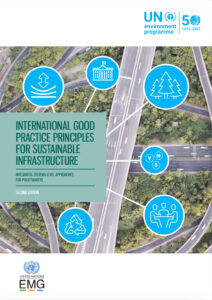As the world prepares for massive investments in infrastructure over the coming years and decades, the United Nations Environment Management Group (EMG) has endorsed a revised second edition of the International Good Practice Principles for Sustainable Infrastructure.
 The updated principles reflect the breadth of knowledge and perspectives from across the UN system. They seek to ensure that 21st century infrastructure promotes environmental, social and economic sustainability. This second edition has been formally endorsed by the EMG’s 51 members and contains a foreword by UN Secretary-General António Guterres.
The updated principles reflect the breadth of knowledge and perspectives from across the UN system. They seek to ensure that 21st century infrastructure promotes environmental, social and economic sustainability. This second edition has been formally endorsed by the EMG’s 51 members and contains a foreword by UN Secretary-General António Guterres.
“Infrastructure investment is a key tool for improving productivity, stimulating economic growth, generating decent jobs, addressing inequalities and building resilience,” writes Mr. Guterres.
“But infrastructure will only deliver on these objectives if sustainability is embedded at its core – increasing society’s resilience while reducing climate risk. A business-as-usual approach to infrastructure would lock in carbon-intensive, unsustainable development and would deal a fatal blow to the aim of Member States to limit warming to 1.5°C.”
The revised edition of the principles has been launched as a follow-up to the fifth session of the UN Environment Assembly (UNEA), which met in Nairobi last March and adopted a resolution on Sustainable and Resilient Infrastructure (UNEA/E.A.5/L.15).
This new resolution builds on a 2019 UNEA resolution (UNEP/EA.4/L.5) by encouraging Member States to: implement the International Good Practice Principles for Sustainable Infrastructure (originally published last year through the UNEP-led Sustainable Infrastructure Partnership); promote investment in sustainable and resilient infrastructure, natural infrastructure and nature-based solutions; cooperate internationally to strengthen frameworks, including for financing; and provide opportunities for engaging relevant stakeholders.
The Organisation for Economic Co- operation and Development (OECD) has estimated that an annual average of 6.9 trillion USD in climate-compatible infrastructure investment is required over the next decade to meet global development needs.
Infrastructure can also have direct and indirect impact on biodiversity and ecosystem services. At the same time, poorly planned infrastructure can exclude certain segments of society from access to services and benefits (for example employment), and large-scale infrastructure development can lead to displacement of entire communities.
Financial sustainability is also a concern, as unaffordable infrastructure projects can burden national and subnational governments with unsustainable debt. In addition, poorly designed infrastructure can lead to high long-term maintenance or replacement costs during operation and have implications for decommissioning.
According to the Global Infrastructure Hub, there is a significant gap between these investment needs and current investment trends, particularly in low- and middle-income countries. Spending on renewables and energy efficiency, for example, creates five times more jobs per 1 million USD invested than spending on fossil fuels. Similarly, investing in climate resilient infrastructure in developing countries can create 4.2 trillion USD in benefits, with a return of 4 USD for every 1 USD invested.
Infrastructure will shape the success of the Sustainable Development Goals (SDGs), as infrastructure is either directly or indirectly influencing the attainment of 92% of the 169 individual SDG targets and also determine whether the world can achieve net zero greenhouse gas (GHG) emissions by 2050 and meet the objectives of the Paris climate agreement.
Sustainability must be integrated as early as possible into infrastructure plans. These Principles – now highlighted in the new UNEA resolution – advocate for inclusive, nature-based, low-carbon and resource-efficient solutions that uphold human rights and deliver economic opportunities for all. Through case studies and accompanying tools, they offer an overarching illustrative guide, ready to be tailored to local contexts.
International Good Practice Principles for Sustainable Infrastructure (second edition) sets out ten guiding principles that policymakers can follow to integrate sustainability into infrastructure planning and delivery:
- STRATEGIC PLANNING to ensure the alignment of infrastructure policies and decisions with global sustainable development agendas and to strengthen the enabling environment.
- RESPONSIVE, RESILIENT, AND FLEXIBLE SERVICE PROVISION to meet actual infrastructure needs, allow for changes and uncertainties over time, and promote synergies between infrastructure projects and systems.
- COMPREHENSIVE LIFE CYCLE ASSESSMENT OF SUSTAINABILITY, including the cumulative impacts of multiple infrastructure systems on ecosystems and communities over their entire lifespans, to avoid “locking in” infrastructure projects and systems with various adverse effects.
- AVOIDING ENVIRONMENTAL IMPACTS of infrastructure systems and investing in natural infrastructure to make use of nature’s ability to provide essential, cost-effective infrastructure services and provide multiple co-benefits for people and the planet.
- RESOURCE EFFICIENCY AND CIRCULARITY to minimize infrastructure’s natural resource footprint, reduce emissions, waste and other pollutants, and increase the efficiency and affordability of services.
- EQUITY, INCLUSIVENESS, AND EMPOWERMENT through a balance between social and economic infrastructure investment to respect, protect and fulfil human rights and promote well-being, particularly of more vulnerable or marginalized groups.
- ENHANCING ECONOMIC BENEFITS through employment generation and support for the local economy.
- FISCAL SUSTAINABILITY AND INNOVATIVE FINANCING to close the infrastructure investment gap within the context of increasingly constrained public budgets.
- TRANSPARENT, INCLUSIVE, AND PARTICIPATORY DECISION-MAKING that includes stakeholder analysis, ongoing public participation, and grievance mechanisms for all stakeholders.
- EVIDENCE-BASED DECISION-MAKING that includes regular monitoring of infrastructure performance and impacts based on key performance indicators and the promotion of data sharing with all stakeholders.
The EMG’s diverse membership of UN bodies is committed to supporting Member States with the implementation of the UNEA resolution and the ten Principles on sustainable infrastructure.
For more information, please contact Rowan Palmer (rowan.palmer@un.org).
About the author
